Whether for thru-hikers spending 6 months on the trail or beginners spending 6 days on their first solo trip, the best backpacking tents are the cornerstone of outdoor preparedness. The right tent can shelter from the elements and critters. In the wild, it’s a home away from home.
Having extensively hiked the Pacific Crest Trail and everywhere from Iceland to Alaska and Patagonia, I’ve learned a thing or two along the way about just what makes the best backpacking tents. My team and I set out to find the shelters you’ll want in your pack when you’re carrying your entire home on your back.
I consider six factors while evaluating the best backpacking tents: ease of setting up, durability and materials, weight and packed size, interior space, weather resistance, and value. The recently updated Big Agnes Copper Spur UL2 is currently a clear favorite overall, and the Six Moon Designs Lunar Solo is a solid budget choice.
Each tent excels in one or more of these aspects, and I’ve awarded outstanding models “Best of” ratings corresponding to their outstanding qualities. So whether you are pinching pennies, are ready to splurge on the tent of your dreams, or just want to replace your tattered gear, there’s a tent here for you.
Editor’s Note: We updated our Backpacking Tent guide on November 26, 2025 to add the Six Moon Designs Lunar Solo as my new best budget choice, as well as the new Durston X-Dome 2, a tent with a unique design that really opens up the interior space.
The Best Backpacking Tents of 2025
Best Overall Backpacking Tent
9.5/10 Rating
Best Budget Backpacking Tent
6.8/10 Rating
Most Spacious Backpacking Tent
8.7/10 Rating
Best Mid-Tier Backpacking Tent
7.9/10 Rating
Best Ultralight Backpacking Tent
9.0/10 Rating
Most Storm-Worthy Backpacking Tent
8.0/10 Rating
Best Backpacking Tent For Families
7.9/10 Rating
See more picks
-
Lightweight -
Stable design -
Roomier than expected -
Excellent interior storage and vestibule design
-
Expensive (not most expensive on our list though) -
Included storage sack doesn’t hold the tent very well -
2-person version won’t fit two wide sleeping pads
-
Affordable with a quality build -
Spacious -
Durable design -
Good ventilation
-
Heavier than most other single pole designs -
Setup takes some getting used to -
Not our favorite door clasp system
-
Fly-first set-up -
Unique floor space maximizes the space you have -
Great overhead inside the tent -
Sil-polyester is allergic to rain -
Available with carbon or aluminum poles
-
Set up is a bit more involved than some tents, with many toggles to attach -
Door zippers require technique to not damage
-
Extremely spacious with lots of headroom for two -
Very straight-forward, user-friendly setup/breakdown -
Well-thought-out interior with numerous pockets -
Footprint is included
-
Somewhat heavy/large for solo backpacking
-
One of the most ultralight two-person shelters out there -
Very compact packed size -
Durable enough for an entire thru hike -
Small footprint for compact sites -
Doors can be closed individually
-
A tight squeeze for two hikers, or anyone tall sleeping on an inflatable -
Expensive -
Rainbow zippers degrade quicker than L-zip designs -
DCF can shrink with age
-
Impressive rain and wind resistance -
Huge amount of internal storage space -
Overbuilt hardware and spare zipper pulls included -
Can be used with an optional stronger pole set
-
Bit heavier than other less-featured backpacking tents -
On the pricier side -
Tough to tell which end is head or foot end
-
Lightweight -
Lots of shoulder and head space inside -
Sturdy, resilient in wind and weather -
Very packable
-
Expensive -
Zippers on door could be smoother
More Great Backcountry Options, Field Tested
The following tents didn’t make the top of our list, but they’re still worthy, lightweight options that we’ve thoroughly tested. If you don’t see a tent that meets your needs among our award-winning choices, chances are one of the tents listed below will work for you.
-
Quick, simple setup -
Lightweight but durable -
Thoughtful storage design
-
Narrow floor plan -
Expensive
-
Durable construction -
Unique, double-wall design -
Simple, four-stake pitch -
Affordable
-
On the heavy side for an ultralight tent -
Small internal storage pockets -
Guy lines are a bit difficult to adjust
-
Great weather protection and ventilation -
Ample space -
Novel dry storage cubbies in vestibules -
Large entry doors
-
Rainfly is hard to set up -
Poles are joined with a plastic union piece
-
Impressive weather-resistance for an UL shelter -
Ideal for terrain that doesn’t take stakes well, or those who don’t carry trekking poles -
Water-resistant door zippers and magnetic tie-back toggles -
Short DAC aluminum poles that pack away well
-
Not the lightest option out there due to the integrated poles -
Price is slightly eye-watering -
Will require more care than other shelters
-
Light but fairly durable -
Accommodating for people over 6 feet tall -
Steep walls
-
Expensive -
Storage system overly complicated
-
Very spacious -
Durable (a great long-term option) -
Footprint included -
Easy set-up
-
Heavier than most backpacking tents
Backpacking Tent Comparison Chart
| Tent | Price | Weight | Height | Floor Space | Materials | Vestibule Area |
|---|---|---|---|---|---|---|
| Big Agnes Copper Spur UL2 | $550 | 3 lbs. | 40 in. | 29 sq. ft. | HyperBead fabric; 15D nylon with 20D solution dyed ripstop | 18 sq. ft. |
| Six Moon Designs Lunar Solo | $260 | 1 lb., 10.1 oz. | 49 in. | 26.3 sq. ft. | 20D and 40D silicone coated polyester | 8.5 sq. ft. |
| Durston X-Dome 2 | $499 | 2 lbs., 11.2 oz. | 43 in. | 32 sq. ft. | 15D polyester with 3500 mm sil/PU coating | 18 sq. ft. |
| REI Co-op Half Dome 2 Plus | $369 | 6 lbs., 3.6 oz. | 42 in. | 35.8 sq. ft. | 75 denier polyester taffeta canopy, 40 denier ripstop nylon fly | 19.2 sq. ft. |
| Zpacks Duplex Lite | $699 | 14.9 oz. | 48 in. | 25 sq. ft. | Dyneema Composite Fabric | 11 sq. ft. |
| SlingFin Portal 2 | $610 | 3 lbs., 5 oz. | 44 in. | 27.5 sq. ft. | 15D no-see-um mesh and 20D SIL/PE nylon floor; 10D nylon 66 fly | 16.8 sq. ft. |
| NEMO Dagger OSMO 3P | $600 | 4 lbs., 7 oz. | 44 in. | 42.8 sq. ft. | OSMO ripstop polyester/nylon blend, polyester floor, aluminum poles | 24.3 sq. ft. |
| NEMO Dragonfly OSMO 2P | $500 | 3 lbs., 2 oz. | 41 in. | 29 sq. ft. | OSMO Ripstop/Nylon blend, aluminum | 20 sq. ft. |
| Durston X-Mid 1 | $269 | 1 lb., 14.8 oz. | 46 in. | 21.3 sq. ft. | 20 denier polyester with 2500 mm sil/PU coating | 20 sq. ft. |
| Marmot Limelight UL 3-Person Tent | $549 | 3 lbs., 9.3 oz. | 46.5 in. | 40.9 sq. ft. | Ripstop nylon floor, ripstop polyester fly | 6.5 sq. ft. |
| Hyperlite Mountain Gear CrossPeak 2 | $950 | 2 lbs., 2 oz. | 42″ | 28.5 sq. ft. | Dyneema Composite Fabrics DCF5, DCF10, and 20D sil-nylon | 15 sq. ft. |
| Sea to Summit Telos TR2 | $449 | 3 lbs., 10.7 oz. | 43.5 in. | 23 sq. ft. | Polyester and aluminum | 19.5 sq. ft. |
| NEMO Aurora 2 | $300 | 5 lbs., 10 oz. | 44 in. | 32.4 sq. ft | 68 D polyester, PU polyester fly | 18.4 sq. ft. |
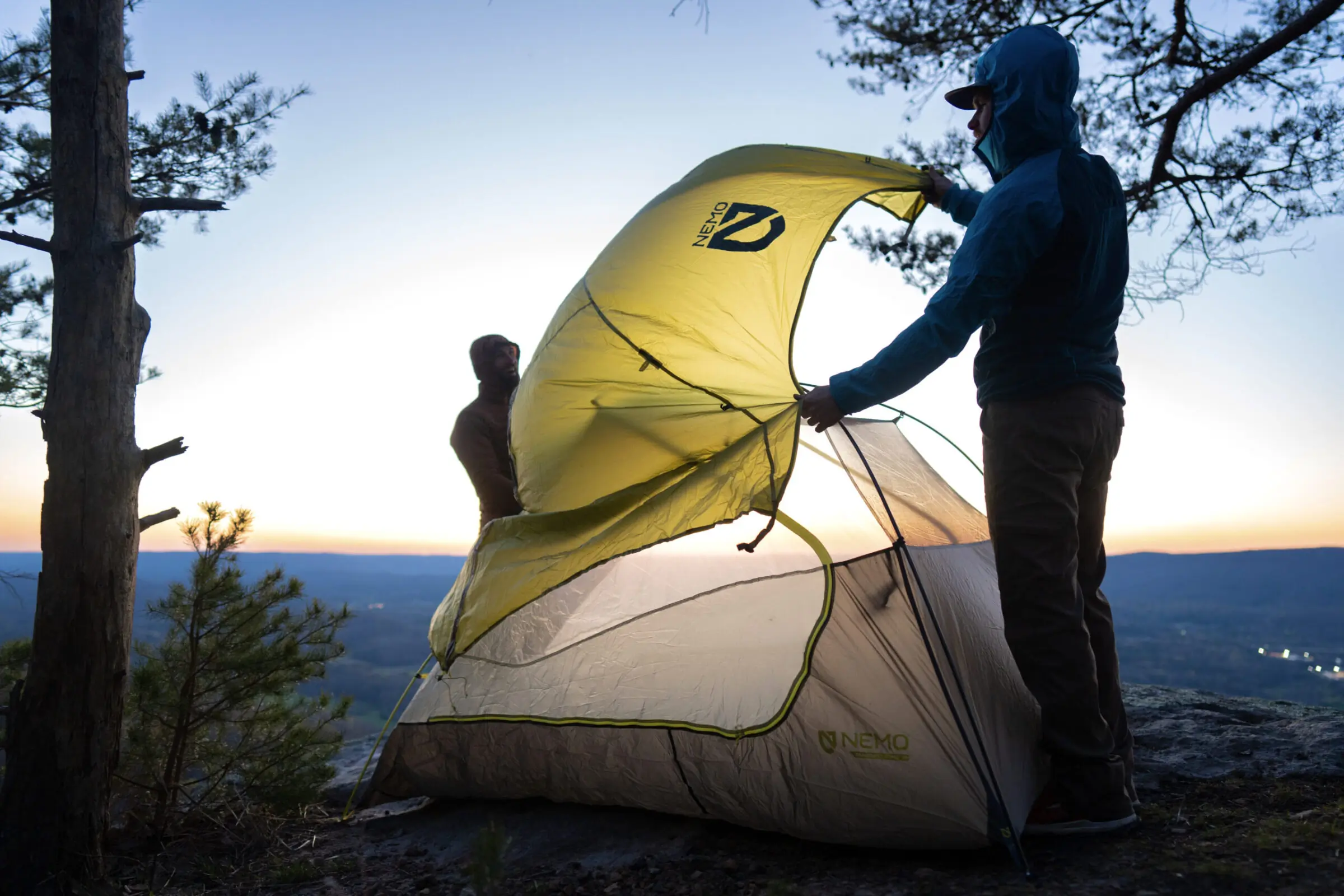


How We Tested the Best Backpacking Tents
It’s no exaggeration to say that the GearJunkie squad has spent thousands of nights under the stars in these lightweight shelters. We’ve schlepped backpacking tents to just about every corner of the globe and have weathered the gnarliest conditions cocooned within their thin walls.
A good shelter is your first line of defense for escaping life-threatening elements in the backcountry — and as such, I don’t take our testing lightly. If you see a model in this guide, you know it’s been vetted by our stone-cold pros and proven to be worthy. Here is how I test and rate each tent:
- Field use: All the backpacking tents we test undergo a thorough field test, and we put them to use for at least one summer before rendering a verdict. Our testers are varied in experience, and all contribute feedback to provide a balanced take.
- Livability and weather resistance testing: Livability is gauged not only by tent floor space, but also by the ease of moving around a tent mate, getting in and out of the shelter, and small details like pockets. Weather resistance is also tested with a garden hose to identify any odd rain entry points.
- Weight and specification measurements: When rating tents, I consider overall internal dimensions, such as peak height, wall angles, and floor space. In 2-person shelters, I look for tents that weigh 3 pounds or less in order to rate highly here. In 3-person shelters, that number is 4 pounds, and while weight is important in a backpacking tent, I try not to ding a tent’s overall score too harshly for weight alone.
- Ease of use scoring: Finally, I rank these tents on ease of use — both in setting them up and in living in them. I look for a good variety of internal storage spots, easy-to-run zippers, wide doors, and ample vestibule space when rating for ease of use.
- Our backpacking tent rating system: I take a broad look at all of our testing feedback from the field, and balance that with my bench testing to rate these tents on the following rubric:
- Space & comfort: 30% weighted.
- Weight: 30% weighted.
- Weather resistance: 20% weighted.
- Ease of use: 20% weighted.
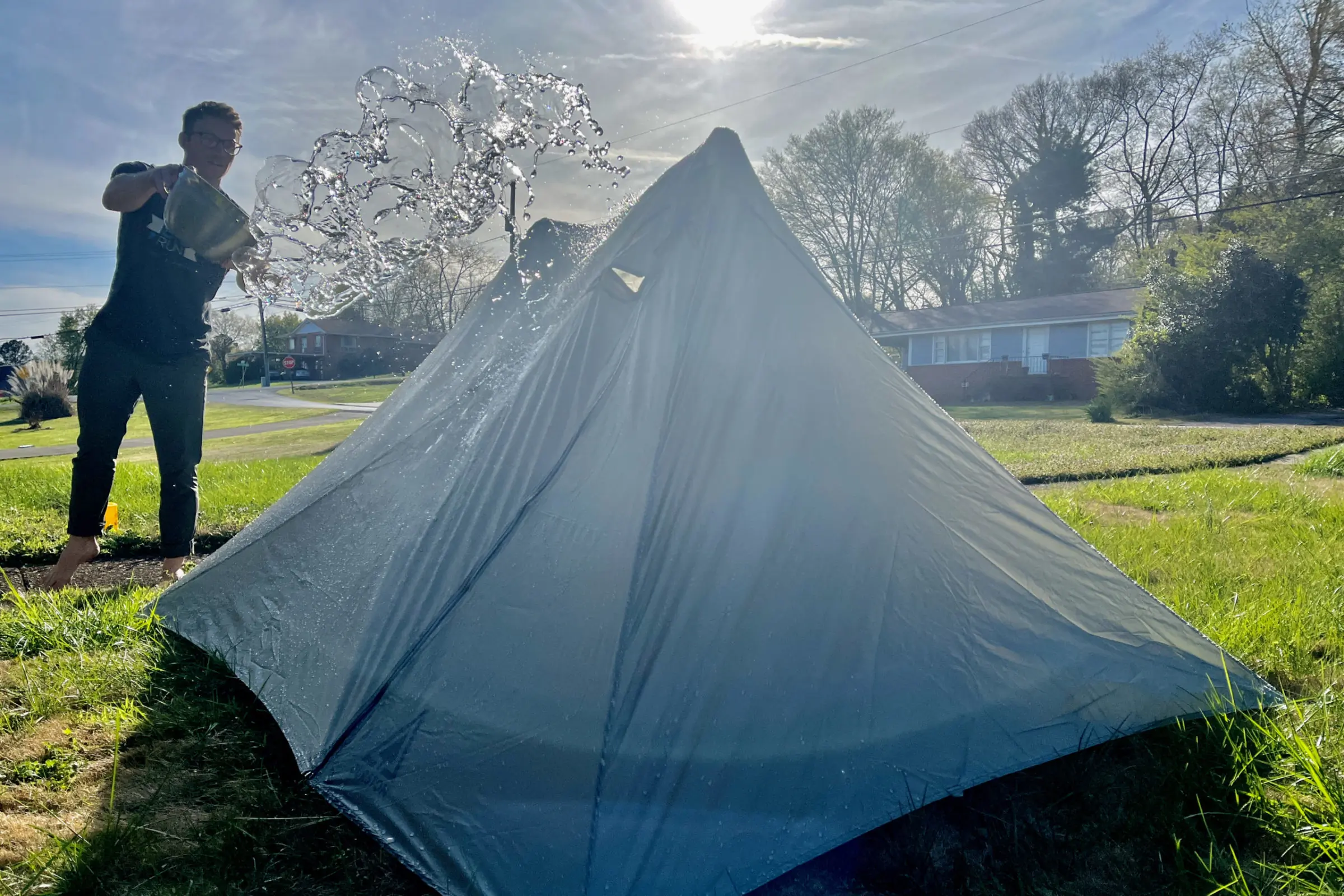



Our Expert Testers
Editorial Director Sean McCoy, a seasoned backcountry hunter, hiker, and all-around outdoorsman, led the charge with this guide back in June 2020, amassing our initial selection of 11 top-shelf tents. Sean is intimately familiar with the necessity of a dependable shelter in the wild and has battled through enough tempestuous nights to know that not all tents are created equal.
Thru-hiker Chris Carter has also added significant testing to this guide. He has thru-hiked the Triple Crown of long trails in the United States: the Pacific Crest Trail, the Continental Divide Trail, and the Appalachian Trail. He’s spent so much time in flimsy backpacking tents that he almost sleeps better in them than under a solid roof.
Finally, I, Senior Editor Nick Belcaster, now lead the testing on this guide. After hiking a few thousand miles of the Pacific Crest Trail in 2018, I’ve got a pretty good idea of what most folks are after in a backpacking tent, and my weekend-warriorhood currently only reinforces that. These days, I’m hot-footing it around the Pacific Northwest, backpacking into the alpine, and carrying it all on my back.
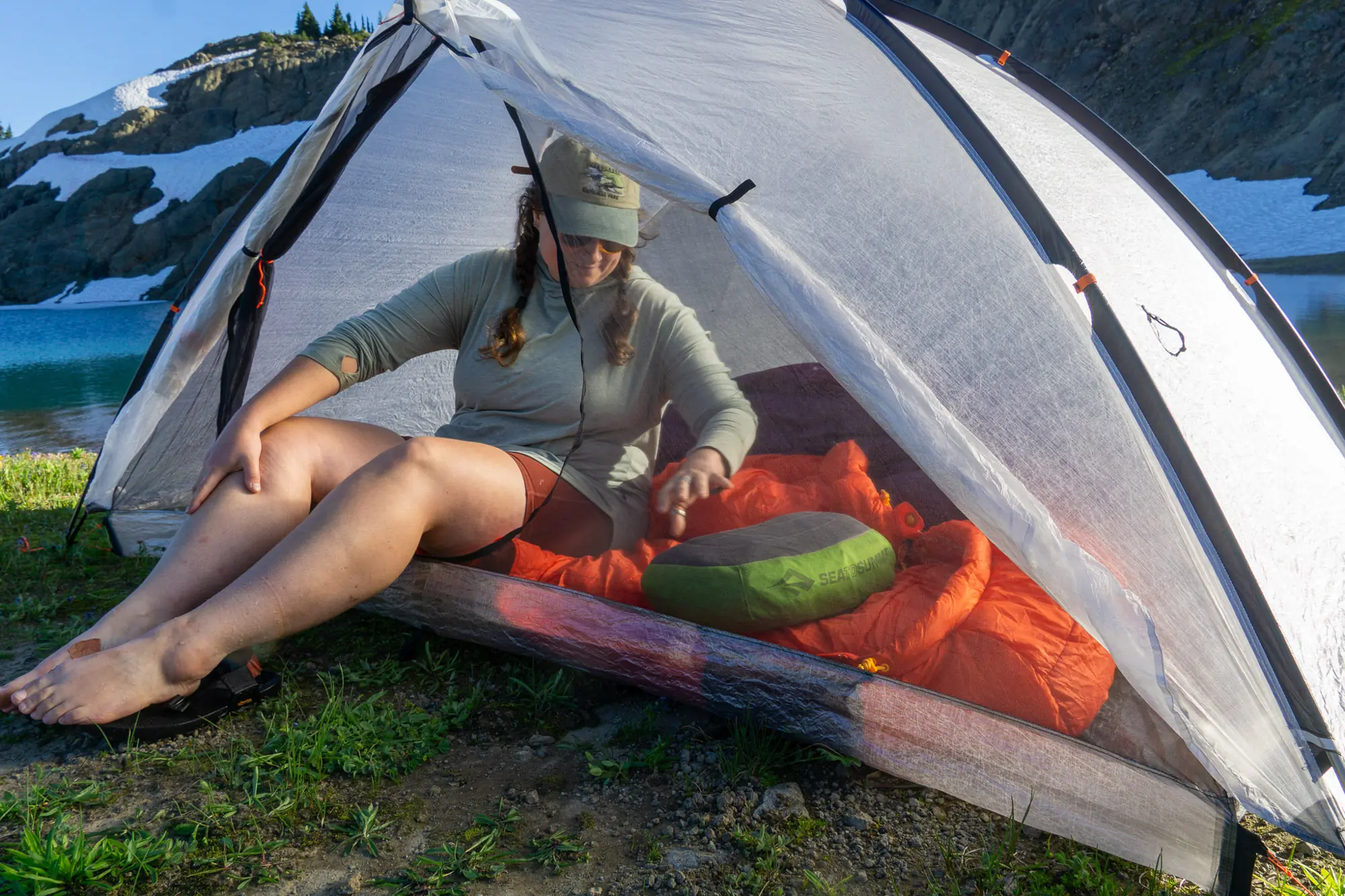



Our Testing Grounds and Process
The GearJunkie team has pitched these tents all over the USA so we can experience them in a wide variety of conditions. The Appalachians provide plenty of rainfall for testing out rainflies. Our testers in the high deserts of the Eastern Sierra and Western Colorado brave high winds and rocky surfaces, where putting up a tent and bomb-proofing it can be extra challenging, especially for the non-freestanding ultralight models.
Calipers, tape measures, scales, timers, and occasionally a garden hose are our bench testing tools of the trade. Weighing every tent ourselves and measuring packed sizes in different configurations are key when it’s time to split hairs and decide which tent is the best.
With so many excellent designs from great manufacturers, sometimes the decision comes down to objective measurements. And during drought years, sometimes we get out the hose or the sprinkler, hang out in the tents, and observe, regardless of what the neighbors think.
If you’re looking for a larger tent for car camping or going to festivals, check out our guide to the best camping tents. If you’re really looking to nerd out on weight savings, we’ve got a guide specifically for ultralight tents. For the real masochists out there, our guide to 4-season tents includes some heavier-duty options than the tents found here.
If you’re not exactly sure, our handy How to Choose the Best Tent for Camping or Backpacking article could be a great place to start.
Buyer’s Guide: How to Choose a Backpacking Tent


The Zpacks Duplex Lite may work for some users who want to go as light and minimalist as possible. On the other hand, the REI Co-op Trail Hut, while heavier, provides a budget option for those who don’t plan to hike as far and want a little more room. Using the six factors I listed at the start of this article as a guide, finding the best backpacking tent can be a simple matter of choosing which qualities are most important to you.
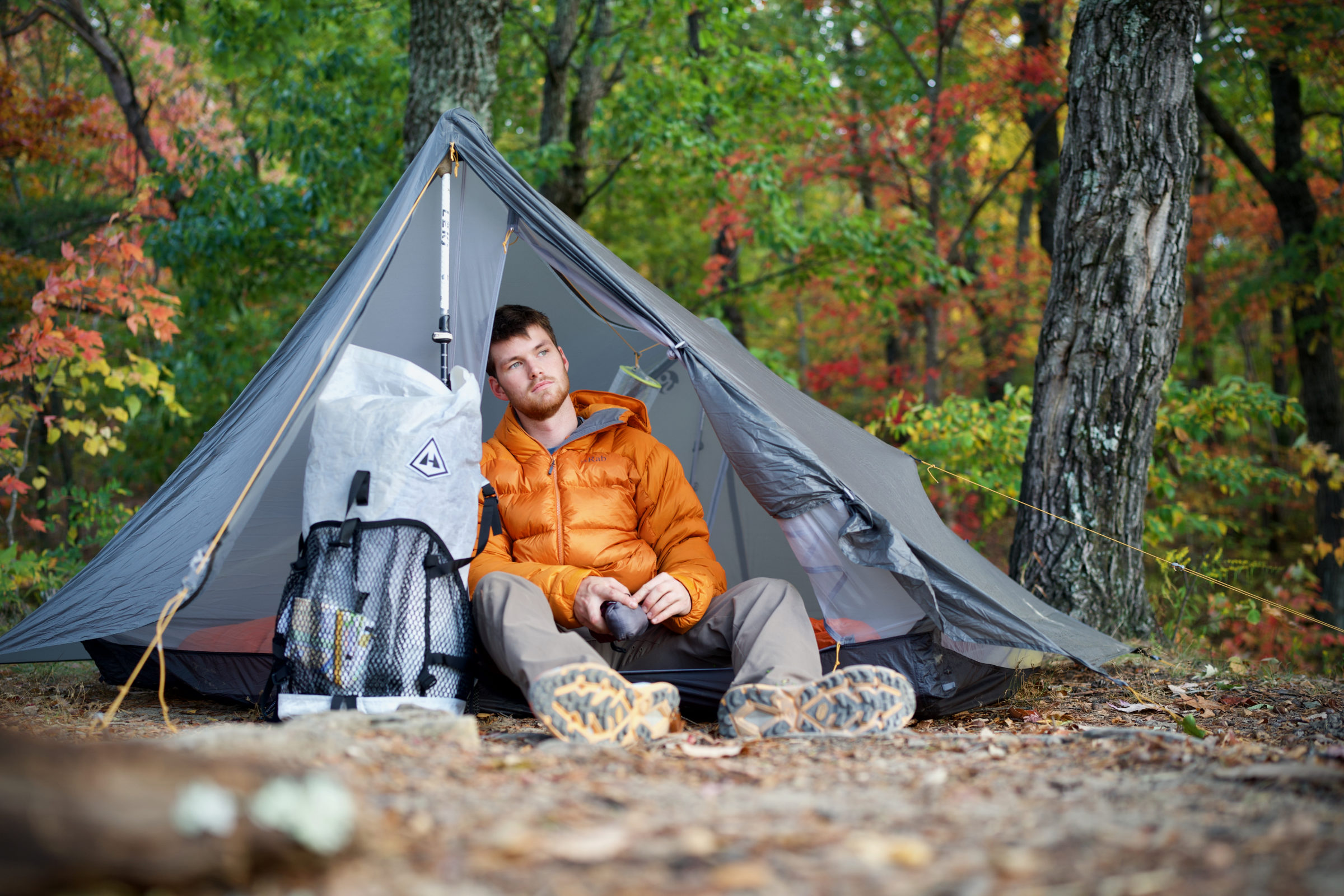

Ease of Setup
This is your first moment with your brand-new tent, and maybe you can intuitively figure out where everything goes, or maybe you need to reference the manual every step of the way. Some tents make setup easy with color-coded poles or poles that are all the same length.
Single-walled winter tents are notorious for barely making room for poles in the material to hold a taut exterior. Still, other tents need numerous guy lines to hold in place and aren’t freestanding without them. Some tout complicated geometric designs with multiple crisscrossing poles, while others are simply held up by one or two trekking poles.
Whatever the case may be, my preference is that the easier a tent is to set up, the better. Of course, domes for alpine basecamps are going to be more difficult than a two-person bug net but will be able to weather much more gnarly terrain compared to a trekking pole-style ultralight option.
The Sea to Summit Telos has many hubs connecting different-length poles, so it pays to try and set this type of tent up in advance. However, the Durston X-Mid 1 simply calls for two trekking poles and four tent stakes. Preference is king and no matter what design suits your experience level, always practice setting it up at home before you go.


Freestanding and Non-Freestanding Backpacking Tents
Many manufacturers have opted to shave ounces by structuring their tents around the trekking poles hikers are already lugging around, simplifying the setup and greatly reducing pack size. These designs are often found in ultralight tents, such as Zpacks’ Duplex Lite and Durston’s X-Mid.
Non-freestanding tents use the tension provided by stakes firmly planted around the trekking or support pole to hold the poles in an upright position. The stakes should consequently be on the longer side and driven into the ground at an angle or reinforced with large stones. Short stakes placed in loose or sandy soil can be easily plucked out by a strong gust of wind, causing your nylon home to fold in around you at three in the morning.
These non-freestanding models are often lighter but are not the best choice for every environment. Ensuring you have adequate ground for stakes can be frustrating for some, and sporting a simple freestanding tent, like NEMO’s Dagger, could be a game changer for easy camp setup. Frantically poking around in rocky earth to pitch your tent as a surprise storm sweeps in is a deflating experience.
Freestanding tents tend to be more durable in inclement weather than their non-freestanding siblings. However, adding trekking poles to the equation eliminates some of the integrity in its structure, making them less ideal in truly heinous storms or driving wind. Ultralight trekking pole tents can hold their own, but a freestanding tent will almost always prove the more stable shelter.
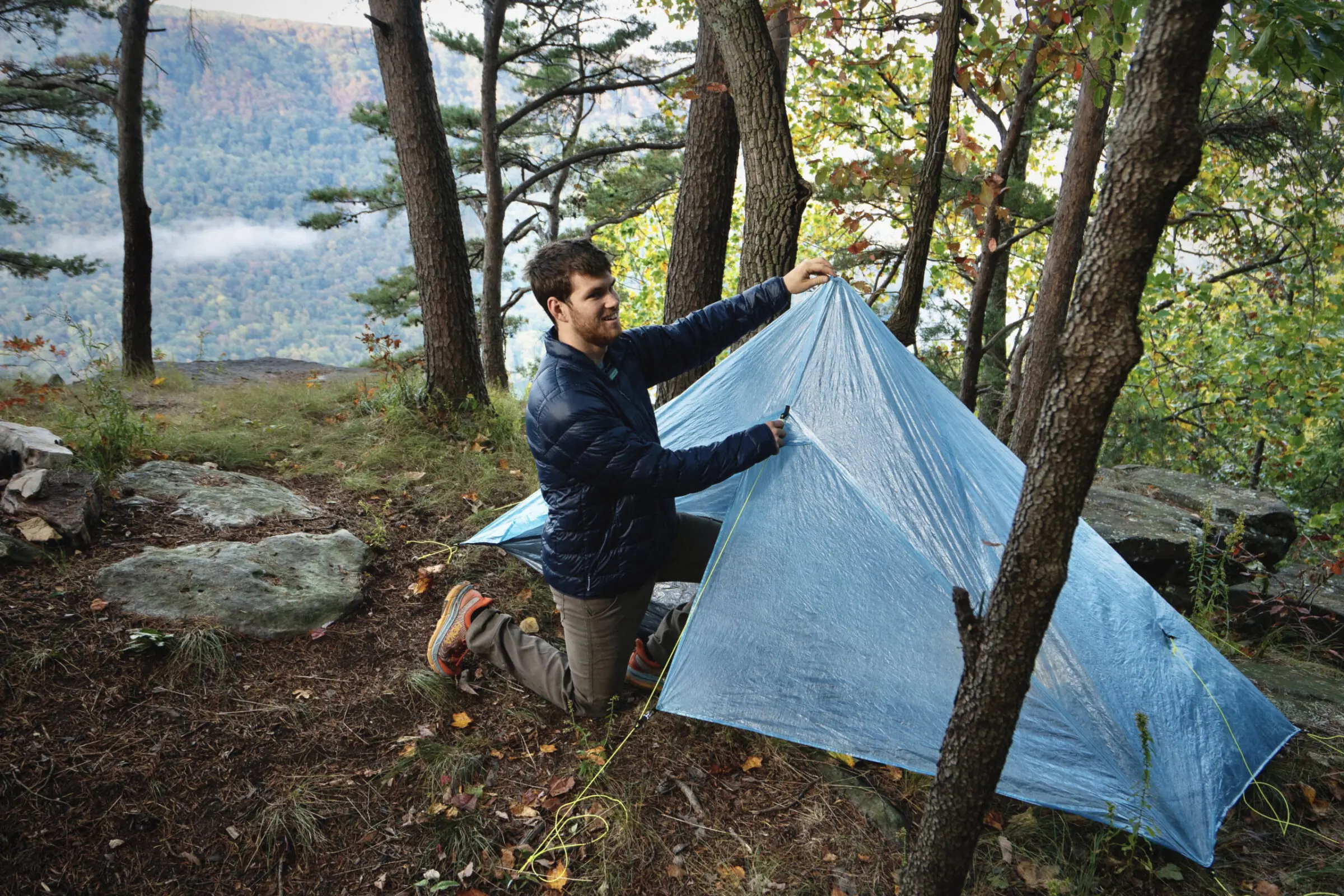



Durability and Materials
Most tents for backpacking are made from nylon fabrics, Dyneema Composite fiber (DCF), or polyester. Each of these materials has its unique benefits, from lower cost to tougher weather resistance or ripstop qualities.
DCF has proven to be an excellent material that is very lightweight and extremely weather-resistant. It also resists tearing — but it is expensive. Unfortunately, it can puncture relatively easily, but crosshatched reinforcement prevents further tearing.
Nylon is a less costly material but is also less durable. Often, it is reinforced against the elements with polyurethane, silicone, or acrylic coating. This makes it more water-resistant but less breathable. Polyester is heavier than nylon and also not particularly breathable.
The thickness of the material is measured in denier units, which are basically the density of fibers measured in grams over meters. The lower the denier count, the lighter the material. Lower deniers are great for reducing pack weight but require more care to prevent rips and tears.


Lightweight tents will usually have 15-20–denier fly and floors. And a heavy car camping or winter tent will have a rating as high as 75 or more.
Then there are the poles. As mentioned above, some tents, such as the Zpacks Duplex or Durston X-Mid 1 forgo their own poles and instead rely on trekking poles to provide structural support. Always be sure to check that your trekking poles are compatible with your tent.
Tent-specific poles are composed of carbon fiber, aluminum, composite, or a combination. Aluminum is light but not nearly as light as carbon fiber or some of the proprietary composites offered today. Aluminum poles are usually found in more affordable models and can withstand rougher handling.
For durability, I like to use a footprint, which usually has to be bought separately. You can always fashion a custom footprint by cutting a piece of Tyvek, which is available at most hardware stores but lacks the grommets and fastening points of a manufactured footprint.
Buying from the manufacturer ensures a proper fit and usually will snap, click, or tie in to integrate with the tent. A lot of ultralight backpackers are going with a crazy light polycryo footprint like this one to shave even more grams.




Weight and Packed Size
If you only plan to car camp, weight, and packed size aren’t major concerns. But anyone planning to haul their tent into the backcountry should take a hard look at these considerations.
An ultralight tent such as the Durston X-Mid 1 is a great option for backpacking or thru-hiking. It doesn’t take up a lot of space or weight in your pack, meaning you can justify bringing a favorite flask or a few extra snacks. But due to the light materials, it’s not as durable as heavier tents and requires more care. The REI Co-op Trail Hut 2 is over three times the weight at 5 pounds, 15 ounces, but is significantly cheaper.
So, you need to balance your needs for weight against durability and cost. You may find that some tents, like the Zpacks Duplex Lite, hit the best of both worlds by using ultra-strong, super-light Dyneema fabric.
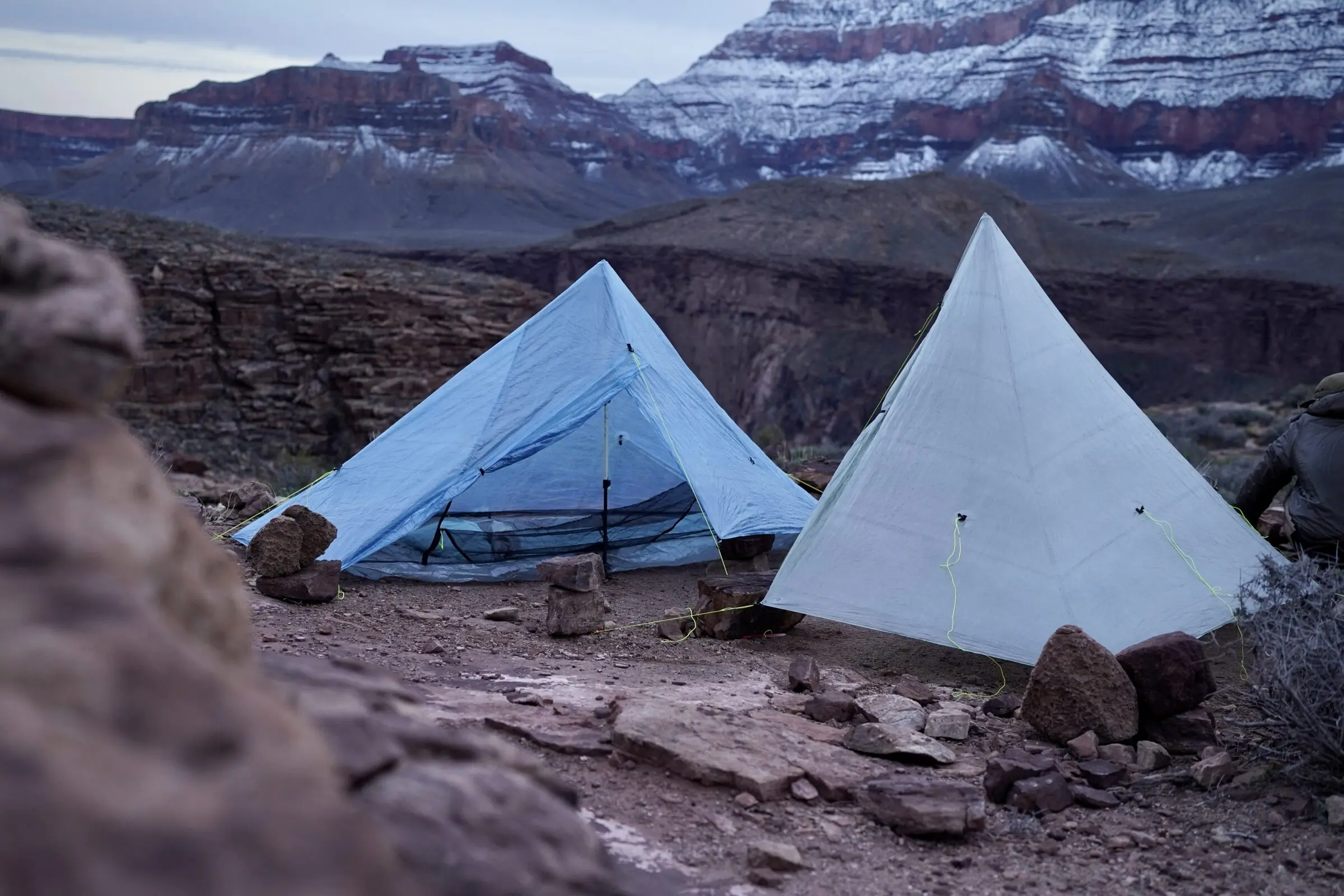



The REI Co-op Arete can seem like a backbreaker compared to lighter tents, but it has loads of headroom and luxurious space. If you are splitting a tent between many people, the extra pounds get spread out. If you are planning a solo thru-hike, coughing up the cash for a small, light tent can save you a lot of back pain.
It’s also a good idea to make sure your tent fits well in your backpacking backpack and leaves space for the rest of your kit before heading out on an extended trip.
Regardless of your choice, be honest with yourself in considering your likely uses. If you expect to do a lot of car camping, it’s smart to carry a little more weight in exchange for durability.
There are large books written on shaving weight for backpacking. The uninitiated may balk at tent prices before a trip, only to learn the hard way that every gram really does add up.
Interior Space




To save weight, you have to be willing to snuggle into a two-person tent and rub shoulders or smell your partner’s feet. Ceiling height is an important consideration as well.
Interior space in a tent equals comfort. The main things to consider are floor dimensions, length, and ceiling height. Tents have a stated number of people they sleep, but how roomy or cramped they will be at capacity varies by brand. And remember, a good backpacking sleeping pad is also critical to a good night’s sleep.
If you are only packing the tent for “just in case” or to mostly store gear, you can downsize to a lighter, more cramped model. Pay attention to the dimensions in the specs from a manufacturer, as they can give you a good idea of how many sleeping pads will fit in it.
Weather Resistance


Basic tents handle pleasant weather like a champ and can even manage light rain and wind. But if you plan to camp during rain or snowstorms (which often roll in unexpectedly), it’s worth it to save up and buy a sturdier tent.
In the event of a storm or condensation buildup, all tents also need ventilation to adequately remove moisture. The Sea to Summit Telos excels in this category with a rollaway fly that can be left open on a warm day to allow all of your items to dry while you are away.
Anything can happen on an extended backpacking trip, and you need to have a shelter that will protect you in driving rain or hail, brutal heat during summer months, or snowy whiteouts in the winter — all while maintaining a lightweight package that easily fits in your bag.
It’s a tall order. But all of the tents on this list have been tested for durability and quality, and we would feel comfortable battling the elements with them.
Many four-season tents are single-wall models. The benefit of a single-wall design is that there is no gap for wind or precipitation to sneak in. Check out our Winter Tent Review for more insight on this topic.
Double-wall designs are far more common for three-season or summer tents. Removable rain flies are a plus if all you need is a barrier from the mosquitoes and you want to stargaze.
If you are confident in the forecast, dropping the fly can bring you to what some call “trail weight,” which refers to leaving out the extra parts to achieve the bare minimum weight.
Vestibules are an important feature to have in inclement weather. They act as a miniature mudroom and provide space for gear storage. The Big Agnes Copper Spur adds a unique design with its awning vestibules. Sealed seams also help buffer against the elements and leakage.
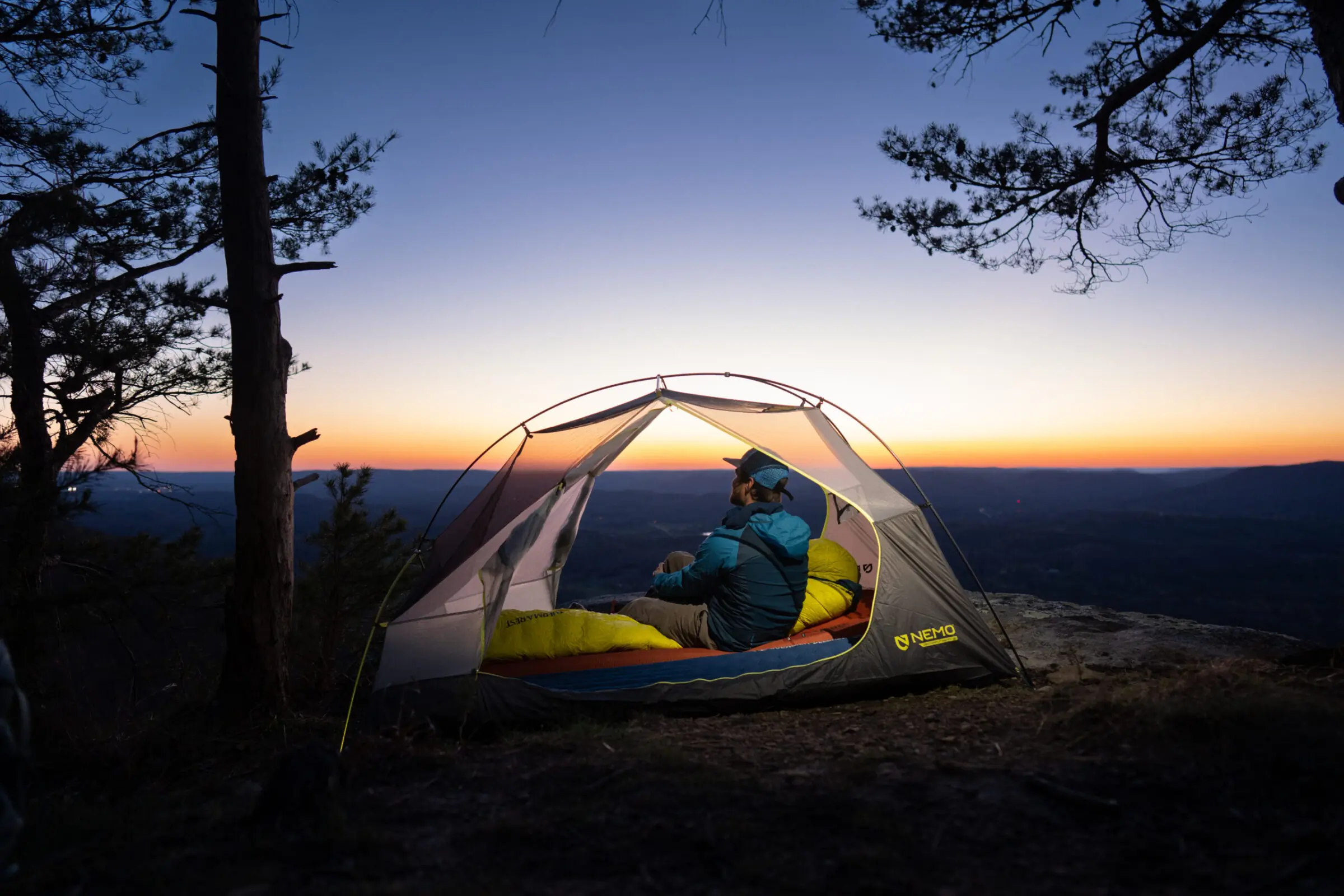



Price & Value
It is hard to put a price tag on the nights of adventure and comfort that a backpacking tent provides. Cost is directly related to the quality of the materials and the packed weight. If you’re willing to spend more, 99% of the time, you’re going to get a tent that’s lighter. The tents tested here are solid in a storm and are durable enough to last many years if handled with care, but I’ve found that weight savings are the main benefit of spending more.
Budget
The Six Moon Designs Lunar Solo ($260) is a case in point when it comes to value for the budget hiker, as it’s light on the wallet but a little limited in backcountry luxury. Still, the sub-2 pound weight will make you feel like an ultralighter, and you’ll have something left in your budget for a sleeping bag or a sleeping pad.
The Durston X-Mid 1 ($239) is a bit more weight for less out of your wallet, but you’ll get an additional door, plus much more interior space for a single backpacker.


Mid-Tier
You can get a solid “mid-tier” tent for $400-500. We use quotes here because many of these tents are anything but “mid,” including our best overall choice, the Big Agnes Copper Spur ($550). This tent is 3 pounds, 2 ounces, has a huge vestibule, and plenty of room for two.
Divided between two people, you’re only carrying a pound and a half, and you’ll have a waterproof base camp for you and all your gear. The $550 NEMO Dagger OSMO 3P is another solid shelter that’s freestanding and uses NEMO’s proprietary OSMO ultralight waterproof nylon.
Premium
If money is of no concern, or you’re staring down a 1,000+ mile thru-hike, you may want to shell out for the lightest most durable materials. These days, that means Dyneema Composite Fabric.
The Zpacks Duplex Lite ($669) is our top pick for ultralight backpacking, weighing a mere 14.9 ounces. The bathtub-style floor, combined with the rainfly, is an excellent weatherproof design that uses trekking poles for support.
Need more space? The Hyperlite Mountain Gear UltaMid 2 ($699) has a 50-square-foot area of coverage, easily enough space for two hikers and gear, and weighs just over a pound. Like the Zpacks Duplex, it relies on your trekking poles for structure.




Frequently Asked Questions
Prices of backpacking tents vary considerably. Materials and the weight of the tent cause prices to range from under $200 (such as the Kelty Late Start 2) to over $1,000 out the door.
Specialized ultralight tents such as the Hyperlite UltaMid or burly all-weather mountaineering tents are usually the most expensive and are made from very strong and light materials.
Less expensive tents are priced for the beginning or occasional hiker. Expect to spend a third of your budget on a tent, another third on your sleeping bag, and the rest on your cooking supplies, etc.
The amount you are willing to spend depends on your commitment to the sport. Affordable options are a great place to start, as you can then gauge your willingness to invest.


When buying a backpacking tent, pay attention to whether it is freestanding, like the REI Co-op Arete ASL 2, or requires trekking poles, like the Zpacks Duplex. Tents that use trekking poles are on average far lighter, but they take guy lines and know-how to set up.
Materials are important to consider as well. The more expensive tents offer light rip-resistant materials like cuben fiber (such as the Hyperlite UltaMid), while more economical models are bulky and heavier (see the REI Co-op Trail Hut). This affects not only weight but also packed size.
Make sure the tent has adequate space for your needs, with floor space, vestibules, and storage. Minimalist tents will be lighter but usually offer less in terms of extra pockets and storage. Tents more suited for car camping will have those amenities but weigh considerably more.
Ultralight tents are fragile, expensive shelters exposed to potentially harsh conditions in the wilderness. The major benefit of a tent like the Six Moon Designs Haven comes in very little weight and volume on your pack.
Having used several ultralight tents, we would say that most backpackers should steer clear of the absolute lightest tents unless they are extremely cautious with their gear.
And by that, we mean they put it away perfectly every time, and even go so far as to load their car and backpack with the care of their gear in mind. We’ve had holes worn in ultralight tents from nothing but friction and vibration during a 2-hour drive, so this isn’t an exaggeration.


So, if ultralight is too light for you, what is a reasonable weight for a backpacking tent? A well-established guideline is about 2.5 pounds per person, meaning a tent under 5 pounds for a two-person tent is reasonable.
The Big Agnes Copper Spur weighs in at 3 pounds, 2 ounces, which is very light split between two people, while the Zpacks Duplex Lite is 14.9 ounces. Both tents are for two people but are made from different materials, and the Duplex depends on your trekking poles to set up.
Many tents offer footprints as an aftermarket add-on. A footprint is a piece of fabric that matches the shape of the tent floor. It often will clip into your tent poles or stake system to integrate with your setup under your tent.
The footprint offers protection against sharp objects on the ground and may increase the lifespan of your tent. However, carrying a footprint adds to the weight of your pack. So, you need to balance the need to protect your tent with the added weight of the footprint.
For ultralight tents such as the Hyperlite UltaMid or Zpacks Duplex, a footprint is often important to prevent damage. That’s somewhat ironic, as the tent is meant to be as light as possible.
For that reason, sometimes a slightly heavier floor build, as on the REI Co-op Arete, makes more sense, as you can leave the footprint behind. For car camping, a footprint is always a good idea, as it will increase the life of your tent.


Head into the backcountry with the best backpacking backpacks of 2025. From budget-friendly options to ultra-comfortable picks, we’ve got you covered.
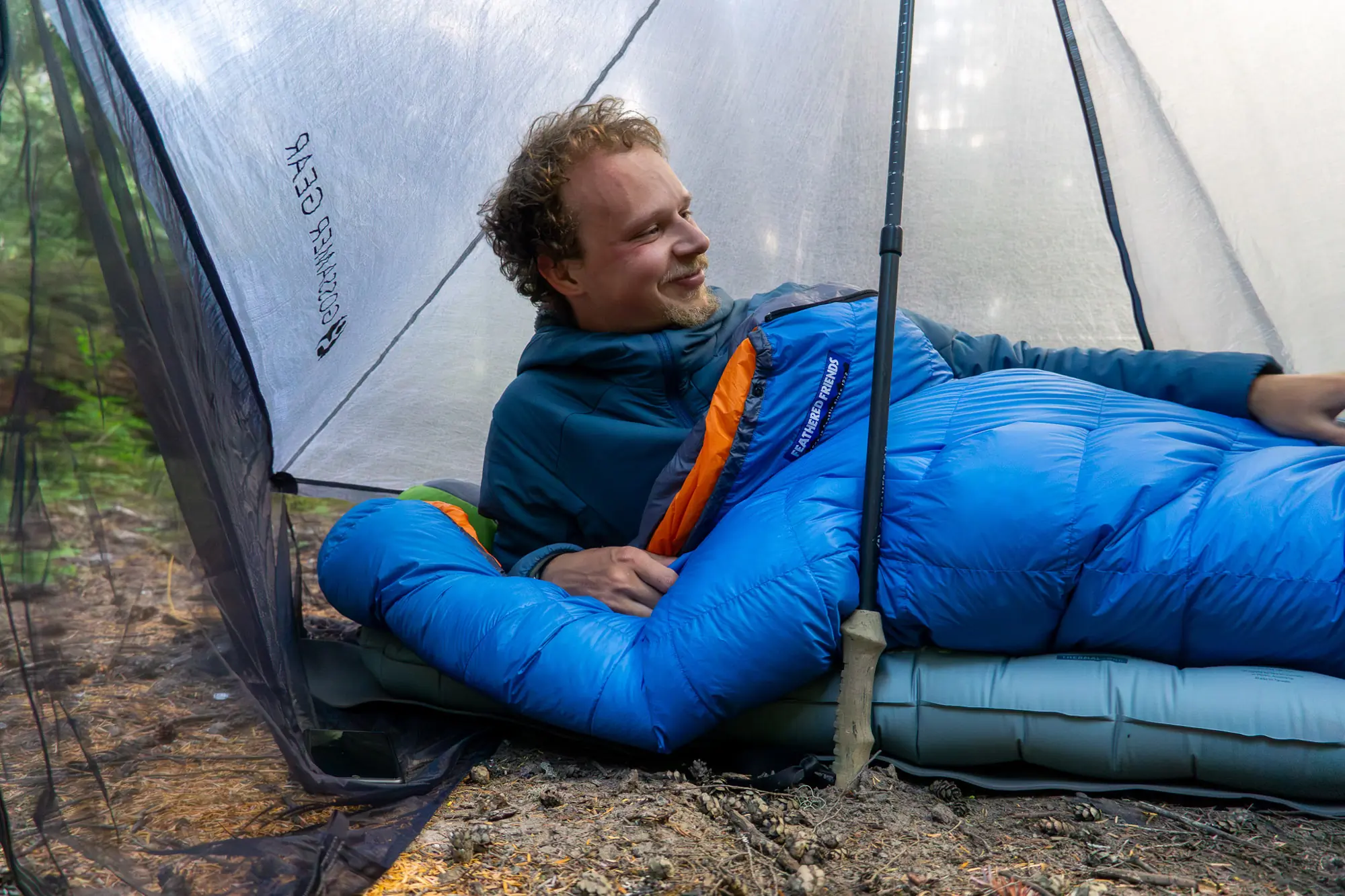

We’ve found the best backpacking sleeping bags for every environment and budget, with top picks from Therm-a-Rest, Mountain Hardwear, NEMO, and more.
Read the full article here




